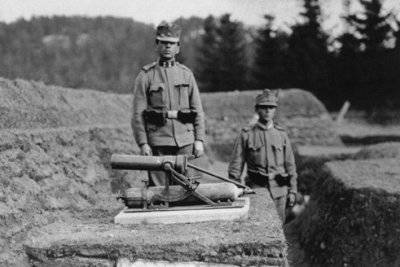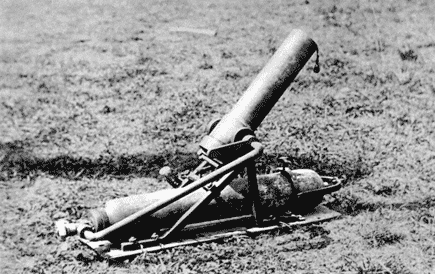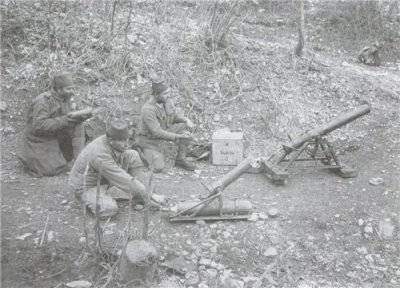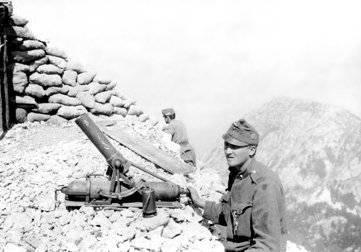Pneumatic mortars: from Austria with zilch
 The First World War will forever remain in the memory of mankind. It will remain not only because of the monstrous number of victims for those times, but also due to the rethinking of the art of war and the emergence of many new types weapons. For example, the widespread use of machine guns as a cover for dangerous areas attracted the development of mortars and light field artillery. Aircraft (of course, enemy) caused the appearance of anti-aircraft artillery and so on.
The First World War will forever remain in the memory of mankind. It will remain not only because of the monstrous number of victims for those times, but also due to the rethinking of the art of war and the emergence of many new types weapons. For example, the widespread use of machine guns as a cover for dangerous areas attracted the development of mortars and light field artillery. Aircraft (of course, enemy) caused the appearance of anti-aircraft artillery and so on.In addition, the artillery and mortars had their own problems - shortly after the start of the shelling, the enemy determined the approximate area from where they were scorched by various methods and opened fire. Of course, in such artillery duels there was nothing good for both sides: both there and there, soldiers had to do their job, at the risk of catching a shard or dying. In this regard, the mortars were easiest: their small weapons were much more mobile than the "full" guns. Having fired several shots, the mortar crew could have left the position earlier than the enemy covered it with return fire. Due to poor development aviation during the First World War, the main way to determine the position of enemy artillery was to detect “by ear”, which involved units of sound reconnaissance. The essence of their work was as follows: if you know where the posts of the “hearing” are located, and there is information about the direction of the sound source (shots) relative to the posts, then calculating the approximate location of the enemy guns is not a particularly difficult task.
 Accordingly, the simplest means of countering sound reconnaissance would be the absence of sound when fired. At first glance, nothing complicated, but do not forget about the practical implementation. This task to the military of different countries seemed to be rather difficult, and not everyone took up its implementation. As a result, only two countries will produce serial, silent mortars - Austria-Hungary and France. However, they will not succeed in ousting the "classic" fellows.
Accordingly, the simplest means of countering sound reconnaissance would be the absence of sound when fired. At first glance, nothing complicated, but do not forget about the practical implementation. This task to the military of different countries seemed to be rather difficult, and not everyone took up its implementation. As a result, only two countries will produce serial, silent mortars - Austria-Hungary and France. However, they will not succeed in ousting the "classic" fellows.The first were the Austrians. Probably, the experience of limited exploitation in the troops of the Windbüchse airgun of the Girardoni design affected. In 1915, the first batch of 80-mm pneumatic mortars went to the trenches. The weapon turned out to be simple: a frame of two triangles, on which the rocking barrel is located, and under it a base plate with a balloon for compressed air. On the left side of the frame set the sector with the marking of the elevation angles. Also to the left, but already on the axis on which the trunk was attached, the elevator positioning lever was placed, which at the same time served as an angle pointer arrow. The shot was made by short-term opening of the valve on the cylinder, the dispenser was not provided. In order for the inept soldier not to “release” all 270 atmospheres in one shot, they applied a new mine form and a method for launching it. In its form, the mine for a pneumatic mortar was more like an ordinary artillery shell - the plumage was removed from it. In turn, several round protrusions of soft metal were added to the side surface. The shot of the new mine took place as follows: when loading the mortar (from the breech), a special disposable obturator was put on the back of the mine, and the mine was inserted into the chamber. Next, the breech was closed, targeting was performed, and the valve on the compressed air cylinder was opened. Up to a certain point, the mine was held in the chamor due to the contact of its protrusions with the protrusions on the inner surface of the trunk. When the pressure increased to the required 35-40 atmospheres (for 80-mm mortars), the soft metal of the mine stops collapsed, and the ammunition with good acceleration flew out of the barrel. After the mine went "to visit" the enemy, the soldier had to close the cylinder valve. Simple and tasteful.
 Yes, only a pneumatic mortar did not become an absolute weapon. Its maximum firing range was within 200-300 meters, depending on the conditions. At first, they tried to change the range with the amount of air supplied, but with the mine containment system used, such adjustment could not be brought to practical use. However, the available range was enough to throw the "gifts" in the nearest enemy trenches. But most of all the troubles were delivered to the soldiers by a balloon. Firstly, because of its thick walls, the mortar was very heavy, and secondly, metallurgy did not yet allow the gas tank to be made relatively strong. So any splinter or even careless handling could lead to bad consequences, from simple pressure relief to almost a blast. Another drawback of the balloon was pressure drops. Shots themselves reduce it, in addition, the weather still affects. The sun was on the balloon - the pressure increased, and with it the firing range at the same elevation. It started to rain, considerably wetted and cooled the balloon - the pressure dropped along with the range. Finally, the cylinder needs to be “recharged” from time to time, and this requires a compressor — a soldier with a hand pump will take an indecent amount of time to refuel. Compressors, in turn, at that time were too large and uncomfortable to keep them in trenches or dugouts right at the front.
Yes, only a pneumatic mortar did not become an absolute weapon. Its maximum firing range was within 200-300 meters, depending on the conditions. At first, they tried to change the range with the amount of air supplied, but with the mine containment system used, such adjustment could not be brought to practical use. However, the available range was enough to throw the "gifts" in the nearest enemy trenches. But most of all the troubles were delivered to the soldiers by a balloon. Firstly, because of its thick walls, the mortar was very heavy, and secondly, metallurgy did not yet allow the gas tank to be made relatively strong. So any splinter or even careless handling could lead to bad consequences, from simple pressure relief to almost a blast. Another drawback of the balloon was pressure drops. Shots themselves reduce it, in addition, the weather still affects. The sun was on the balloon - the pressure increased, and with it the firing range at the same elevation. It started to rain, considerably wetted and cooled the balloon - the pressure dropped along with the range. Finally, the cylinder needs to be “recharged” from time to time, and this requires a compressor — a soldier with a hand pump will take an indecent amount of time to refuel. Compressors, in turn, at that time were too large and uncomfortable to keep them in trenches or dugouts right at the front. Another country, having weighed the pros and cons of pneumatic mortars, probably would have refused them. But the Austrians decided differently and already in 1916-m launched the production of large-caliber weapons: from 120 to 200 millimeters. In the course of their operation, one characteristic and useful feature of a pneumatic weapon became clear: the projectile accelerated in the barrel more smoothly and with far less acceleration than in powder. Thus, it was possible to shoot ampoules with poisonous substances from a pneumatic mortar of large caliber without the risk of their destruction in the barrel. By the end of the war, almost all pneumominets were transferred to such a “job”.
Another country, having weighed the pros and cons of pneumatic mortars, probably would have refused them. But the Austrians decided differently and already in 1916-m launched the production of large-caliber weapons: from 120 to 200 millimeters. In the course of their operation, one characteristic and useful feature of a pneumatic weapon became clear: the projectile accelerated in the barrel more smoothly and with far less acceleration than in powder. Thus, it was possible to shoot ampoules with poisonous substances from a pneumatic mortar of large caliber without the risk of their destruction in the barrel. By the end of the war, almost all pneumominets were transferred to such a “job”.However, at the end of the war (by the way, for Austria-Hungary, it ended very badly), the pneumatics left all classes of weapons except small arms, and there it is used exclusively in sports and hunting. Pneumatic field weapons of other countries were not long in the army either. Starting from the interwar period, such projects, although they appear from time to time, have become the lot of projectors and lone handicraftsmen. Serious gunsmiths abandoned this idea.
Information